Attainment Scotland Fund evaluation - Headteacher Survey: 2021 report
This report presents key findings from the sixth survey of headteachers of schools in receipt of Attainment Scotland Fund (ASF) support, covering the 2020 to 2021 academic year including the period of school building closures from January to March 2021.
2. ASF and supported approaches
2.1. This section summarises survey findings on respondents’ experiences in developing their approach, including schools’ response to changes during the COVID-19 pandemic, and engagement with families and communities.
Developing the approach
2.2. A great majority of survey respondents felt they understood the challenges and barriers faced by pupils affected by poverty; 96%, including 72% who felt they understood this ‘to a great extent’. This is broadly similar to the 2020 and 2019 surveys, but survey results show some variation across key respondent groups; in particular, PEF-only schools, primary schools, those in rural areas, and those with lower PEF allocations were less likely to feel that they understood these challenges.
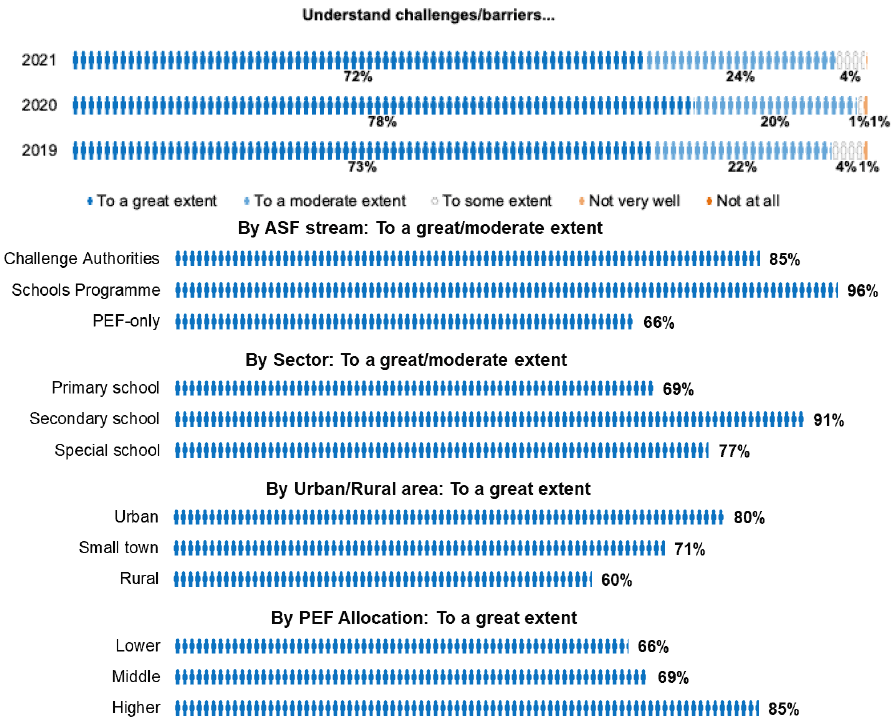
2.3. A large majority of headteachers felt they are aware of the range of potential approaches available to their school in closing the poverty-related attainment gap; 95% indicated this, including 62% who were ‘very aware’. These findings are similar to those of the 2020 and 2019 surveys, but some variation was evident across key respondent groups; PEF-only schools, those in rural areas and those with lower PEF allocations were less likely to feel that they are aware of potential approaches.
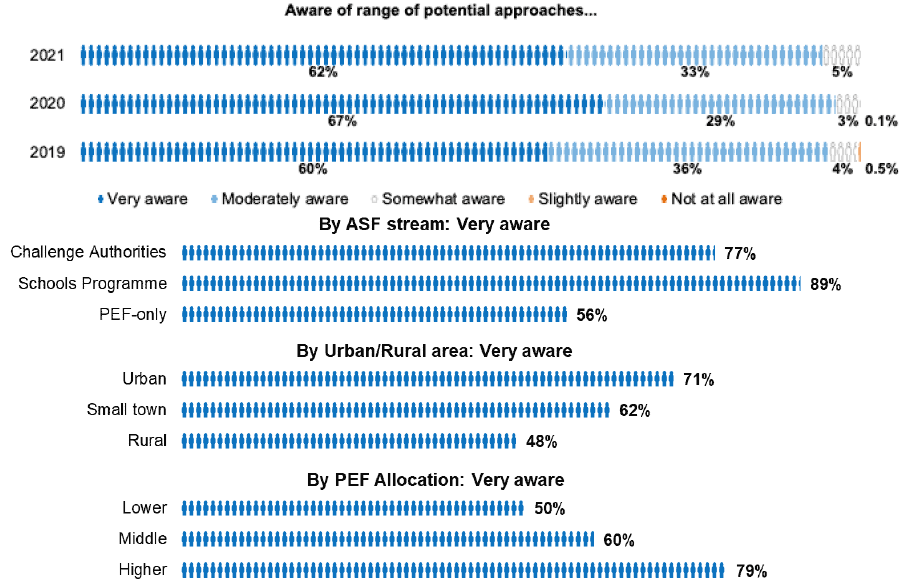
2.4. A large majority of headteachers indicated that they feel confident selecting the most effective approaches to closing the poverty-related attainment gap; 92% indicated this, very similar to the 2020 and 2019 surveys. There was some variation across key respondent groups with PEF-only schools, those in rural areas and those with lower PEF allocations less likely to feel confident in selecting approaches to closing the gap.
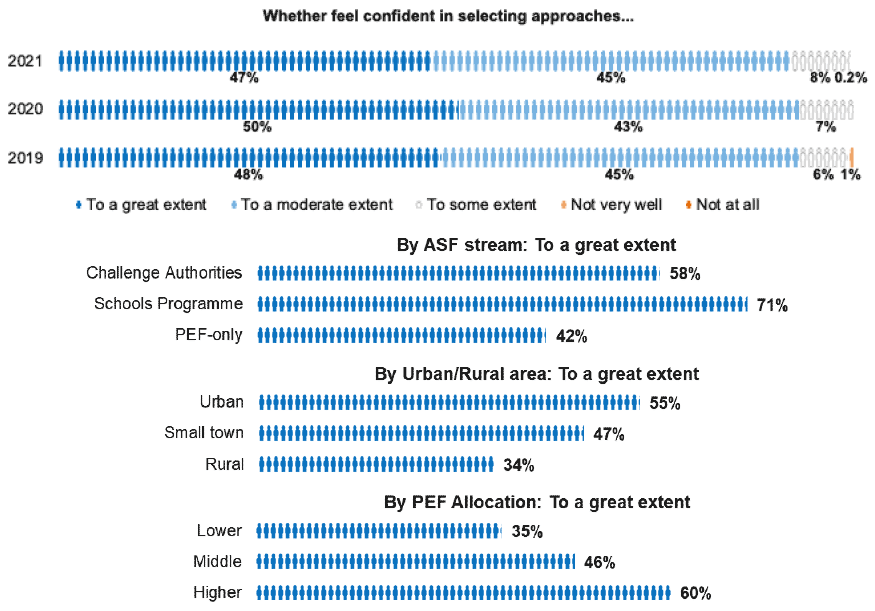
2.5. The majority of headteachers (81%) felt that the approach to achieving equity in education is embedded within their school community. These findings are very similar to 2020 and 2019 survey results and were consistent across most respondent groups, although it is notable that those in rural areas and those with lower PEF allocations were less likely to feel that their approach to equity was embedded.
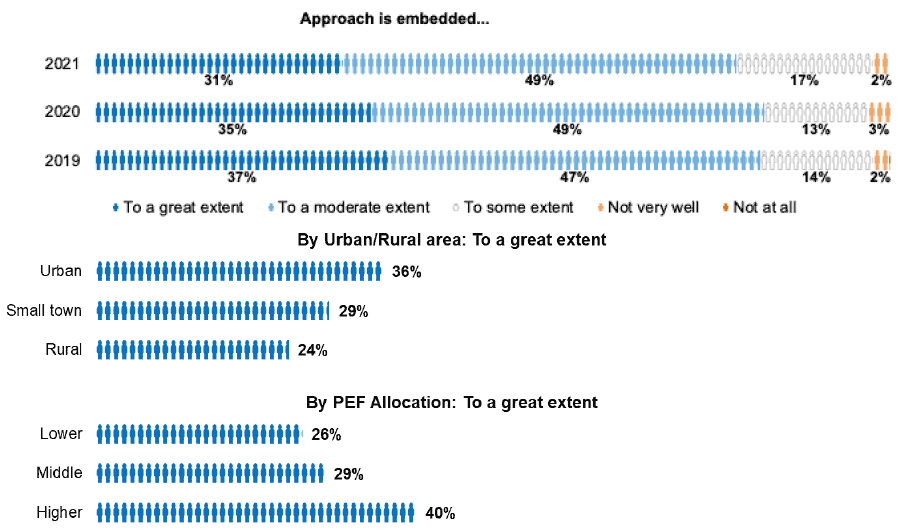
Focus for achieving equity in education
2.6. A large majority of survey respondents have included a focus on the pupils or parents experiencing socio-economic deprivation or disadvantage as part of their approach to achieving equity; 82% include a focus on those experiencing socio-economic deprivation and 79% include a focus on other types of disadvantage.
2.7. Most took a mixed approach, with 85% indicating that they have used ASF to support ‘universal’ approaches. The great majority of these (82%) supported universal approaches alongside other approaches with a focus on those experiencing socio-economic disadvantage.
2.8. These findings are very similar to previous surveys, and are consistent across most key respondent groups. However, schools in rural areas are less likely to have included a specific focus on those affected by socio-economic deprivation.


2.9. Headteachers have seen a range of new circumstances affecting families since school building closures that may need to be taken into account by their approach to closing the poverty-related attainment gap. The most common was an increase in pupils and/or parents in need of support with mental health and emotional wellbeing; 99% of headteachers felt this has become more common since school building closures, including 78% who felt this had become ‘much more’ common.
2.10. Other circumstances seen as affecting an increasing number of families were difficulties accessing support services due to COVID-19 (65% felt this is much more common), families struggling with remote learning (51%), digital connectivity issues (44%), and pupils/parents needing support with their physical health and wellbeing (40%).
2.11. Headteachers reporting an increase in digital connectivity issues and needing support with physical health and wellbeing is consistent with the 2020 survey.[6] However, survey results suggest an increasing focus on pupils and parents in need of support with mental health and emotional wellbeing. While an increase in mental health needs was amongst the new issues raised by respondents to the 2020 survey, this is now (by some margin) the most commonly cited new issue affecting families.
2.12. Survey results also show some variation across key respondent types, particularly in views on the incidence of families affected by poverty and insecurity of employment:
- An increase in the number of families affected by poverty was most likely to be reported by PEF-only schools, secondary schools, those in rural areas and those with higher PEF allocations;
- An increase in families affected by insecurity of employment was most likely to be reported by PEF-only schools; and
- An increase in pupils and parents needing support with their physical health and wellbeing was most likely to be reported by those with higher PEF allocations.
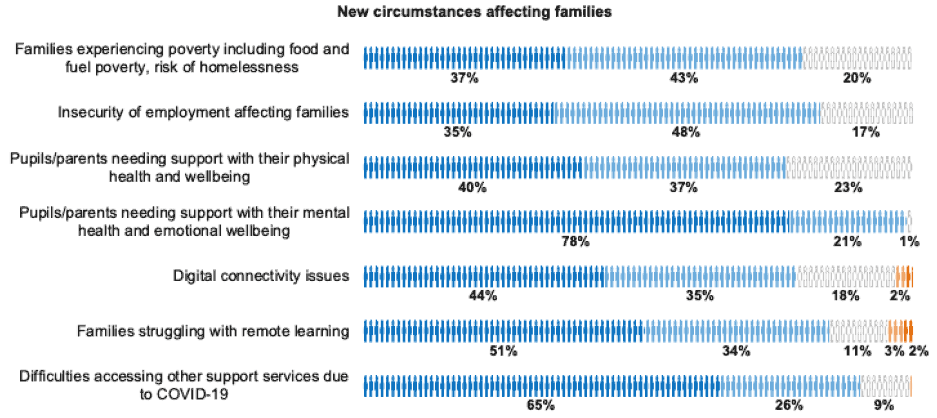
2.13. Headteachers referred to a wide range of approaches used in response to these new circumstances affecting pupils and families. Consistent with the profile of new circumstances listed at Figure 7, the most commonly used approaches were a greater focus on mental health (87% had used this), more support for remote learning (77%), more support with digital connectivity (76%), and additional staffing skills and capacity (71%). These are also consistent with the approaches reported in the 2020 survey.
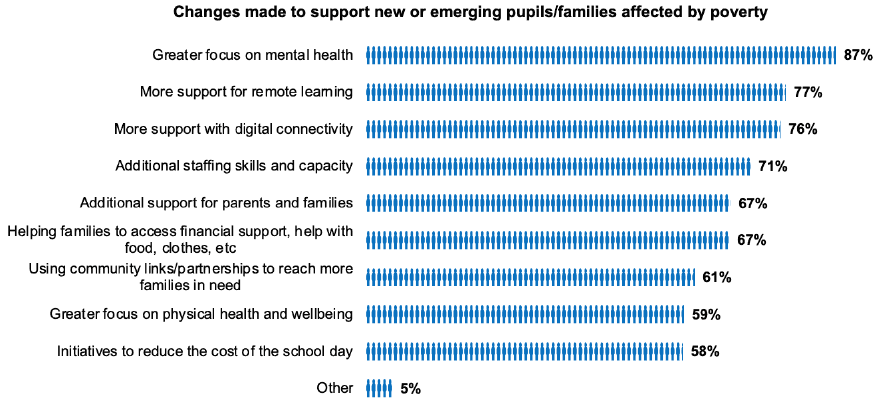
Responding to changing circumstances
2.14. The majority of survey respondents indicated that their approach to achieving equity had changed from the previous school year (2019/20); 83% indicated this, including 16% where the approach had ‘developed significantly’. This is very similar to the 2020 survey, but represents an increase on the 2019 survey where 67% indicated that their approach had changed from the previous year. It is also notable that those with lower PEF allocations were less likely to indicate that their approach had changed.
2.15. Most (77%) further developed their approach to achieving equity during school building closures in January to March 2021. There was some variation in this finding across key respondent groups, with those in rural areas and those with lower PEF allocations less likely than others to have changed their approach to closing the gap during school closures.
2.16. Survey results also suggest that schools where the approach to achieving equity had changed from 2019/20 were also more likely to further develop this during school building closures in 2021. The great majority (91%) of those who had significantly changed their approach from 2019/20 further developed this during school building closures in 2021, compared to a little more than half of those who had not changed their approach from 2019/20.
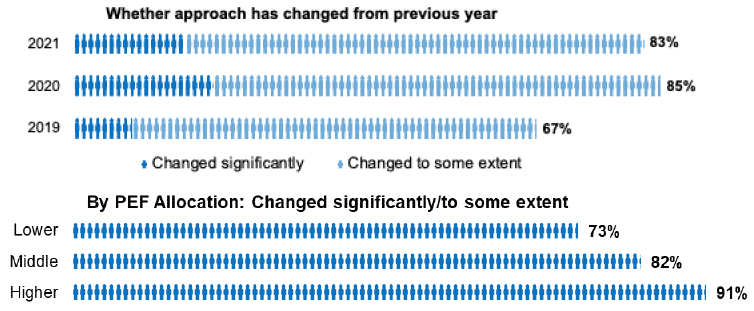
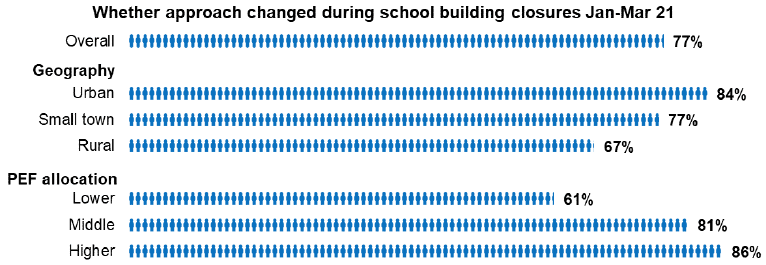
2.17. The majority of schools (73%) had used the greater flexibility in how they use ASF funds introduced in response to the COVID-19 pandemic, a 16-point increase on the previous survey. There was some variation across key respondent groups in take-up of this flexibility, most notably that those in urban areas and those with higher PEF allocations were more likely to have made use of this flexibility.
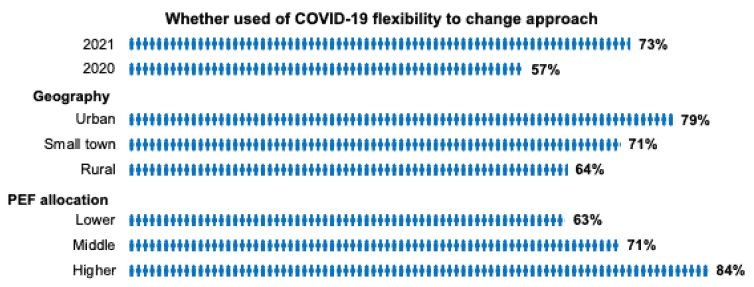
2.18. Flexibility introduced in response to COVID-19 was most commonly used to secure additional staffing capacity; 82% of schools indicated this. In terms of other ways in which flexibility was used, digital resources and connectivity (used by 65%), support for those affected by poverty (52%), and supporting more family and community engagement (46%) were also common. Survey results showed some variation across key respondent groups in how COVID-19 flexibility had been used:
- Support for those affected by poverty was most commonly referenced by Challenge Authority schools, those in urban areas and those with higher PEF allocations.
- Additional support and specialist learning services were more likely to be mentioned by secondary schools, those in urban areas and those with higher PEF allocations.
- Building links with external partners was most commonly referenced by Challenge Authority schools, those in urban areas and those with higher PEF allocations.

2.19. The majority of headteachers indicated that their experience of the COVID-19 pandemic in the previous school year (2019/20) helped their approach during 2020/21; 77% indicated this, including 22% who felt that their prior experience had helped shape their approach ‘to a great extent’. Survey results suggest that those with lower or middle PEF allocations were less likely to feel that their approach this year had been helped by their prior experience of COVID-19 in 2019/20.

2.20. Schools were asked to describe in their own words what aspects of 2020/21 they had found more challenging than 2019/20, and what they had found less challenging. The main points raised by respondents are summarised at Tables 3 and 4.
| Engaging and supporting families, maintaining communication and meeting support needs remotely | 39% |
|---|---|
| Maintaining remote learning, ongoing digital connectivity/literacy challenges | 26% |
| Increasing pupil mental health and welfare needs, including anxiety around return to school – cumulative impact of pandemic and lockdown periods | 25% |
| Challenges maintaining pupil engagement in learning through the pandemic | 25% |
| Ability of parents and families to support pupils, including the impact of increased poverty and mental health needs | 21% |
| Concerns for staff resilience and morale, including anxiety around return to schools | 17% |
| Responding to staff absences, managing staff workload | 15% |
| Challenges tracking impact and assessing attainment, including concerns around potential widening of the attainment gap | 10% |
| Limited access to other agencies and support services such as CAMHS, speech and language, Educational Psychology | 9% |
| Maintaining the safe operation of the school, responding to changing regulations | 9% |
| Pupil absence due to self-isolation, limited one-to-one contact | 8% |
| Nothing was less challenging | 23% |
|---|---|
| Improved digital skills for pupils, families and staff, and reduced digital exclusion for families | 21% |
| Refined approach to remote learning and wider response to school building closures – a much smoother transition | 20% |
| Better communication with families, improved understanding of pupil and family needs | 13% |
| More one-to-one contact with pupils, especially important for vulnerable pupils, including those benefiting from hub placements during school building closures | 9% |
| Staff developed skills and adapted approaches | 7% |
| Better engagement with remote learning from pupils and families | 7% |
| Operation of school hubs enabling more targeted and intensive approaches, and increased one-to-one contact with pupils | 5% |
2.21. The aspects which headteachers most commonly highlighted as having been more challenging than in the previous year were engaging and supporting families including challenges maintaining communication and meeting support needs without families being able to come into schools; managing remote learning and responding to ongoing digital connectivity and literacy challenges; responding to increased pupil mental health and welfare needs; challenges maintaining pupil engagement in learning as the pandemic continued; reduced ability of parents and families to support pupils including more families being affected by poverty and mental health needs; and concerns for staff resilience and morale. Headteacher comments also noted that some of these challenges – such as concerns for pupils, families and staff resilience – reflected the cumulative impact of the pandemic. This included several headteachers suggesting that some had found the second period of school building closures more challenging, including reports of a more significant adverse impact on pupil wellbeing.
2.22. In terms of aspects of the school year which headteachers had found less challenging than in the previous year, it is notable that a substantial proportion of respondents suggested that nothing had been less challenging. This included some who felt that 2020/21 had been even more challenging than 2019/20.
2.23. For those who had seen less challenging aspects of their experience, these most commonly reflected areas where schools were able to draw on their previous experience of the pandemic. This included improved digital skills for pupils, families and staff; a more refined approach to remote learning resulting in a smoother transition during school building closures; and better communication with families leading to an improved understanding of pupil and family needs.
Engagement with families and communities
2.24. The majority of survey respondents had used engagement with families and communities as part of their school’s approach to closing the poverty-related attainment gap; 82% indicated this, including 47% who used family/community engagement ‘to a great extent’. This is very similar to the previous survey. Findings also show some variation across key respondent groups; as was found in 2020, those with higher PEF allocations were more likely to have used family and community engagement.
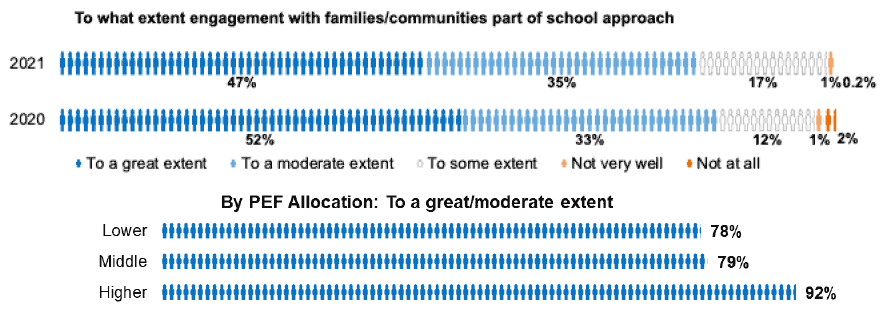
2.25. Schools were asked to describe in their own words how they had developed their approach to family and community engagement in 2020/21, particularly during school building closures. The main points raised by respondents are summarised at Table 5.
| More ‘outreach’ communication with families inc. regular 'check in', gathering feedback, improving understanding of circumstances/needs | 66% |
|---|---|
| Use of digital resources/platforms and provision of digital support | 32% |
| More tailored approach, supporting the most vulnerable families | 24% |
| More community engagement, building links with community support | 14% |
| Provision of remote learning resources | 13% |
| Tackling poverty, deprivation, supporting access to financial support, support with food and clothing | 11% |
| Greater focus on wellbeing including mental health and emotional support, counselling | 9% |
2.26. Consistent with the 2020 survey, extending use of ‘outreach’ communication was the most common way in which schools’ approaches to family and community engagement had developed. The majority of those providing comment referred to increasing contact with families to build relationships, and to improve the identification and understanding of local needs. This included some referring to family wellbeing checks was part of a wider focus on supporting mental health and wellbeing.
We were in touch with our families on a weekly basis by phone. Teaching staff spoke to their class and usually parents on a daily basis, leaving voice notes of encouragement in their feedback. Senior Management Team picked up families needing more support, ensuring those families received the time they needed. (Challenge Authority school in urban area)
Some families were contacted more often, depending on their needs. The chats were informal, prioritising the wellbeing of all but opportunities were used to discuss and support learning. These calls were tracked and monitored. The school also worked closely with partners to support families…families were also supported by the head teacher and partners to access financial aid. (Schools Programme school in a rural area)
2.27. A substantial proportion of respondents also described their use of digital resources and platforms as part of their engagement with families, including the provision of digital support to those with limited connectivity and/or digital literacy. This included specific reference to greater use of social media as a communication and engagement tool, and to resources or platforms such as MS Teams, Seesaw and Google Classroom enabling schools to maintain more frequent ‘continuous’ communication with families.
Communication with parents is more continuous through [digital platforms]. Parents are happy to see their children's learning journeys and still very much feel part of the school community. Online parent meetings are more regular, shorter and more productive. Parents’ skills in IT have developed to enable them to engage with school. (PEF-only school in rural area)
2.28. A specific focus on engagement and support with the most vulnerable families was highlighted as a key aspect of outreach communication for some respondents. These schools referred to having used a range of communication options such as telephone, video messages and social media, and use of engagement approaches such as survey approaches, and virtual sessions focused on issues such as health and wellbeing, mindfulness, and family quizzes or other social events.
Our direct support to families became more focussed in terms of health and wellbeing and support for remote learning. The group of young people who we considered to be most at risk had a programme of focussed support. Our partners were able to continue their work and extend it with an increased emphasis on financial support and access to other services such as food banks. (PEF-only school in small town)
A more personalised approach with regular calls to families struggling to engage, doorstep visits and tailored home learning packs. Once allowed, bubble group sessions for targeted children improved connection with families. The use of See-Saw platform increased parental engagement, as did online live assemblies and weekly family quizzes. These were often the highlight of the week. (PEF-only school in rural area)
2.29. The survey also asked headteachers about what they felt were the main learning points from their experience of family and community engagement in 2020/21. The main points raised by respondents are summarised at Table 6.
| Proactive communication, building relationships, maintaining engagement especially when limited to remote contact | 54% |
|---|---|
| Impact of home environment, parents' capacity to support pupils learning | 34% |
| Importance of digital skills and connectivity in supporting pupils’ learning | 31% |
| Role of schools as sources of wellbeing support for pupils and families | 29% |
| Importance of building a real understanding of families circumstances and needs | 13% |
| A focus on mental health and emotional wellbeing | 11% |
| The impact of poverty, deprivation and disadvantage on families | 8% |
2.30. The value of proactive communication and approaches to maintain engagement with families was the most commonly cited learning point from schools’ engagement with families and communities. This included reference to the challenges of building and maintaining relationships with families, particularly where restrictions limit scope for in-person contact with families.
The importance of regular communication with parents/carers to ensure they feel included when they are not able to visit the school in the way they would have previously. (PEF-only school in urban area)
Communication has been key to continued engagement. Information should be shared in smaller, more digestible chunks - families had so much to deal with that they needed this. It has become even more important to spend time with families, talking and listening. (PEF-only school in rural area)
2.31. Headteachers also highlighted the extent to which their experience of family engagement during the pandemic had highlighted the important role of the home environment and parents’ capacityto support pupils’ learning.
Don't assume everyone has same ability to support children at home. Not all children will get the same experience, no matter what you provide or how creative the teaching is...they need to be in school. Parents have little confidence in supporting pupils at home, and some themselves have poor literacy/numeracy. Parents need to be further encouraged to have a greater role in their children's learning. (PEF-only school in urban area)
2.32. Schools indicated that their experience, particularly during periods of school building closure, had highlighted the importance of digital skills and connectivity. This included reference to the value of improved digital skills within schools, and the support required to ensure families can make effective use of digital resources available to them.
Equity - all had access to digital technology and connectivity during the pandemic as we were able to support this. Much more support had to be put into upskilling parents so they could both get online and also support than the relatively easier quick fixes of connectivity. (PEF-only school in rural area)
2.33. A substantial number of headteachers also referred to the increased role that schools have played in providing support to pupils and families. This reflected the value of building positive relationships with families and communities, with some suggesting that building trust had led to more families turning to schools for support.
In times of social isolation, many parents turn to the school for support in cases of family breakdown/domestic situations/support with finances. Many families trust school and staff with their worries and concerns and believe we can support them. (Challenge Authority school in urban area)
Contact
Email: socialresearch@gov.scot
There is a problem
Thanks for your feedback